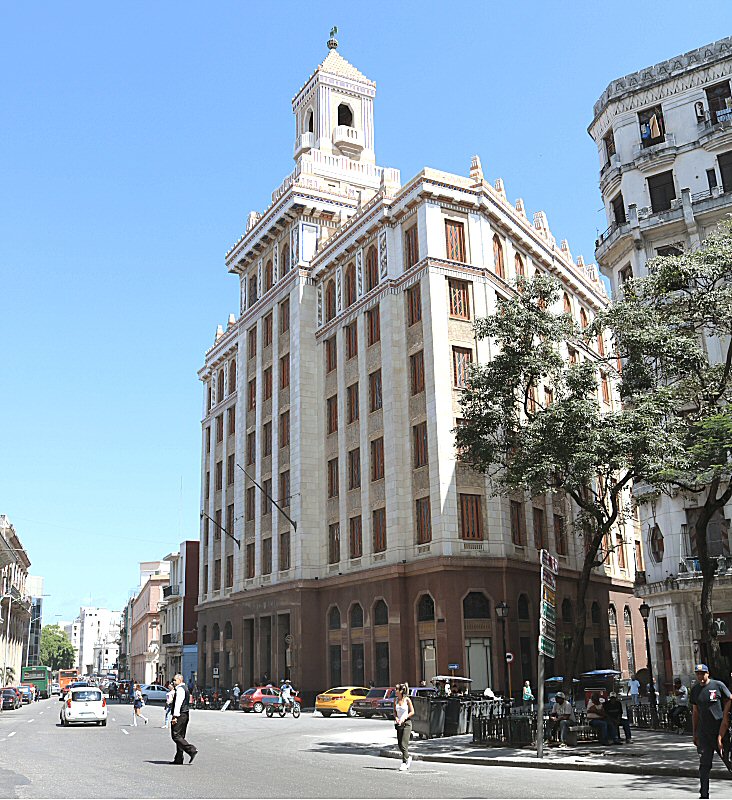
The Edificio
Bacardí is located on the Avenida de Bélgica #261,
bordered by the Empedrado and the San Juan de Dios streets,
about 150 meters north to Floridita bar restaurant.

 The
gorgeous Bacardí building
stands as the symbol of the wealth and
influence of the Bacardí empire founded by Don
Facundo Bacardí Massó in Santiago de
Cuba in 1862. However, the company no longer operates in
Cuba,
as all alcoholic beverages industries
in Cuba was confiscated by the government after the
revolution and all rum factories were united under the name
of Corporacíon Cuba Ron that makes the trade under the name
of Cubaexport. The Bacardí building is Havana’s
first skyscraper and after its construction it continued to
be one of the city’s tallest buildings.
The
gorgeous Bacardí building
stands as the symbol of the wealth and
influence of the Bacardí empire founded by Don
Facundo Bacardí Massó in Santiago de
Cuba in 1862. However, the company no longer operates in
Cuba,
as all alcoholic beverages industries
in Cuba was confiscated by the government after the
revolution and all rum factories were united under the name
of Corporacíon Cuba Ron that makes the trade under the name
of Cubaexport. The Bacardí building is Havana’s
first skyscraper and after its construction it continued to
be one of the city’s tallest buildings.
HISTORY
Cuba was the largest producer of
sugar in the Caribbean in the early decades of the 20th
century. The Bacardí Company, taking advantage of this, was
extending its market at an unprecedented pace, influenced
also positively by the World War I that made the sugar trade
particularly lucrative. The new cocktails, made by Bacardí
rum like the Daiquirí and the Mojito, were widely acclaimed
in the USA.
When the US Congress prohibited the production, sale and consumption of alcohol in 1920, the Bacardí Company in Havana closed its bottling factory in New York, and started with the campaign, promoting Cuba as a tropical island ideal for people that want to escape from the restriction of alcohol consumption in USA. The efficient tactics of this strategy, such as the mailing of the postcards that illustrate the allure of the Havana nights with the Bacardí rum cocktails, and the encouragement of a major airline company the US customers by phrases like “to fly to Cuba and to bath in Bacardí rum”, turned out satisfactory and American tourists flocked to the bars of Havana. Additionally, the new cocktails made by Bacardí rum helped the company to be known worldwide.
With the expansion of the company, a new building worth its name that would serve as the headquarter, became necessary. The company launched a contest and invited limited number of architects, offering 1.000 pesos for the first project. The jury was made of Henri Schueg Chassin, the president of the Bacardí company, and the architects Leonardo Morales, Enrique Gil, Emilio de Soto and Pedro Martínez Inclán. The project presented by the architect Esteban Rodríguez Castells won the first prize. The architect Rafael Fernández Ruenes and the architect and engineer José Menéndez Menéndez were the other partners of Castells’ project. According the project of Castells, the proposed building had a neo-Renaissance style, but after he visited the Exposition Internationale des Arts Décoratifs et Industriels Modernes in Paris in 1925, he completely changed the design to Art Deco style.
The construction began on the lot of 1.320 m2, located on the Avenida Bélgica between the San Juan de Dios and the Empedrado streets in January 1930 and completed in 300 days, in December of the same year, as it was written in the contract. The contractor company was the German Grasyma von Wunsiedel that didn’t made any concession to use the most qualified construction material and took great care to complete the building at the committed date, although the ground conditions were not so good.
When the Bacardí building was completed, it became the tallest building on the island at that time and its elegant black-and-gold decorated bar was opened to celebrities, including the Spanish royal family. Henri Schueg, the husband of Amalia, one and only daughter of Don Facundo Bacardí Massó, the founder of Bacardí y Compañía, launched a brilliant marketing campaign that lured the Americans to the new Bacardí Building in Havana. His motto “Cuba as the home of rum and Bacardí as the king of rums” worked well.
In 1960, the
revolutionary government confiscated all alcoholic beverages
industries in Cuba, so that all these companies with all
their assets passed to the hand of the Cuban State. In the
period of 2001 through 2003 the building was restored by an
Italian firm. At present the building is occupied by the
offices of several national and foreign companies, primarily
by tour operators. Inside it still retains its original
decoration, as well as the exterior of the building, both in
very good conditions. The bar restaurant in the mezzanine
that continued its service after the revolution, is closed
currently.